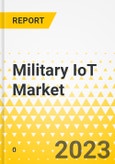This report comes with 10% free customization, enabling you to add data that meets your specific business needs.
The global military Internet of Things (IoT) market pertains to deploying IoT technologies and solutions within the defense and military sectors. In a military context, IoT involves the integration of interconnected devices, sensors, and systems designed to gather, transmit, and analyze data for diverse military objectives. These objectives encompass augmenting situational awareness, refining logistics and supply chain operations, streamlining equipment maintenance, and elevating military activities' overall efficiency and efficacy.
By leveraging IoT technologies, military organizations can monitor and manage critical infrastructure, equipment, and vehicles in real time, reducing downtime and ensuring readiness. Furthermore, the military IoT market facilitates advanced communication and coordination among military units, enabling seamless collaboration during missions and operations. It supports the implementation of intelligent decision-making systems, aiding commanders in making informed choices swiftly and effectively.
Key Trends in the Global Military IoT Industry
- AI and analytics
- Health monitoring systems
- Processors and transmitters
- Data storage
- Security
IoT is a powerful technology for innovation and progress, poised to reshape industries and improve various aspects of our lives by harnessing the capabilities of interconnected devices and data-driven insights. As IoT technology continues to evolve, it is poised to redefine the landscape of modern warfare and defense operations. Military forces are gaining unprecedented situational awareness and operational efficiency with an ever-growing array of interconnected devices, sensors, and data analytics capabilities. This evolution enables the development of smarter and more agile defense strategies, including remote operations with unmanned systems and enhanced logistics management.
This report provides a snapshot of the current market landscape, covering key trends, opportunities, and challenges. The report highlights its diverse applications, from training and simulation to surveillance systems. Additionally, the report profiles leading companies and startups in the military IoT space, offering insights into their strategies and innovations. With a focus on market size, growth projections, and regional dynamics, the global military IoT market report is a valuable resource for stakeholders, including government entities, defense contractors, and technology providers, seeking to understand the key trends and opportunities for IoT within the military sector. With the global military landscape undergoing significant transformations, this report provides a strategic roadmap for those looking to navigate the complexities of this evolving field.
The Key Segments are
By Applications:
- Training & Simulation
- Monitoring Soldier's Health
- Gathering Battlefield Data
- Equipment and Vehicle Fleet Management
- Smart Bases
- Data Processing & Analysis
- Surveillance System
By Technology:
- WiFi
- Cellular
- Radio- Frequency Distribution (RFID)
- Satellite Communications
- Other
By Component:
- Hardware
- Software
- Services
The global military IoT market is further broken down into major regions: North America, Europe, the U.K., Asia-Pacific and Japan, China, South America, and the Rest of the World. The report provides data for each of these regions, with in-depth country-level analyses covering the period from 2022 to 2033.
Product Description
The military IoT employs WiFi, cellular, RFID and satellite communication technologies to create a highly interconnected and data-driven ecosystem. These technologies enable the seamless exchange of critical information, enhancing the military's surveillance, reconnaissance, logistics, and decision-making capabilities. The global military IoT also includes hardware, software and services.
Key Market Players
The key market players in the generative AI market are AeroVironment, AT&T Inc., Bombardier, FLIR Systems Inc., Forescout Technologies Inc., FreeWave Technologies, General Atomics, General Electric, Honeywell International and IBM Corporation.
This product will be delivered within 5-7 business days.
Table of Contents
Companies Mentioned
- AeroVironment
- AT&T Inc.
- Bombardier
- FLIR Systems Inc.
- Forescout Technologies Inc.
- FreeWave Technologies
- General Atomics
- General Electric
- Honeywell International
- IBM Corporation
- Northrop Grumman Corporation
- Reliance Industries Limited
- SAP SE
- Textron Systems








